NDVI stands for "Normalized Difference Vegetation Index". NRG stands for "Near-infrared / Red / Green". NDVI and NRG are both ways to visualize the amounts of infrared and other wavelengths of light reflected from vegetation. Because both these methods compare ratios of blue and red light absorbed versus green and IR light reflected, they can be used to evaluate the health of vegetation. It's a snapshot of how much photosynthesis is happening. This is helpful in assessing vegetative health or stress. (Read more here: https://www.agronomy.org/publications/jeq/articles/36/3/832) ## Do-It-Yourself These techniques for vegetation analysis were developed for satellite imagery, but at Public Lab, we've been working a lot on capturing infrared imagery using our DIY [near-infrared camera](/wiki/near-infrared-camera) setup, and combining it with visible bands to produce NDVI images such as the one above. ## What these images mean What exactly are these images we're trying to make? What do they tell us about vegetation, and why? These diagrams should help to understand what it is we're doing and why these are good ways to analyze plant life. ## The NDVI equation [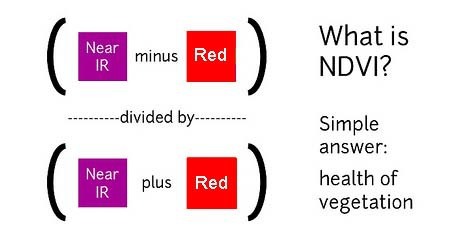](/i/44723) **NDVI = (Near Infrared - Red)/(Near Infrared + Red)** NDVI is a ratio which tries to emphasize photosynthesis while filtering out sun glare. The above equation is run for every pixel, using source data from an infrared photo and a visible light photo, like this pair: [](https://publiclab.org/system/images/photos/000/021/771/original/5390895115_c9d4d38fec_o.jpg) The result can be false-colored to make the high-photosynthesis areas more clear, and used to examine where plants are and how healthy they are. [](https://publiclab.org/system/images/photos/000/021/770/original/PetVISNDVIcomp.png) _Figure above: Normal color photo (right) and normalized difference vegetation index (NDVI) image (left). NDVI image was derived from two color channels in a single photo taken with a camera modified with a special infrared filter. Note that tree trunks, brown grass, and rocks have very low NDVI values because they are not photosynthetic. Healthy plants typically have NDVI values between 0.1 and 0.9. -- @cfastie_ ### Activities Here are a range of activities you can do to produce and interpret your own NDVI imagery, whether downloaded from a satellite imagery provider or [collected yourself using a DIY technique](/wiki/multispectral-imaging) [activities:ndvi] ****   Most DIY converted cameras today (those from Public Lab) use RGN instead of NRG, so the blue channel represents infrared instead of the red channel. That looks like this: [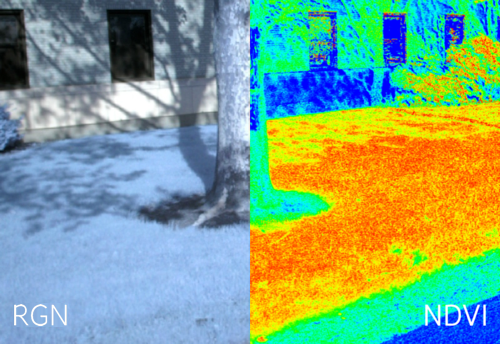](/i/45468?s=o) **** ## NRG imagery Some people are also interested in producing NRG imagery (like the below image), where `Near-Infrared, Red, and Green` are used to compose a picture instead of the usual `Red, Green, and Blue`. [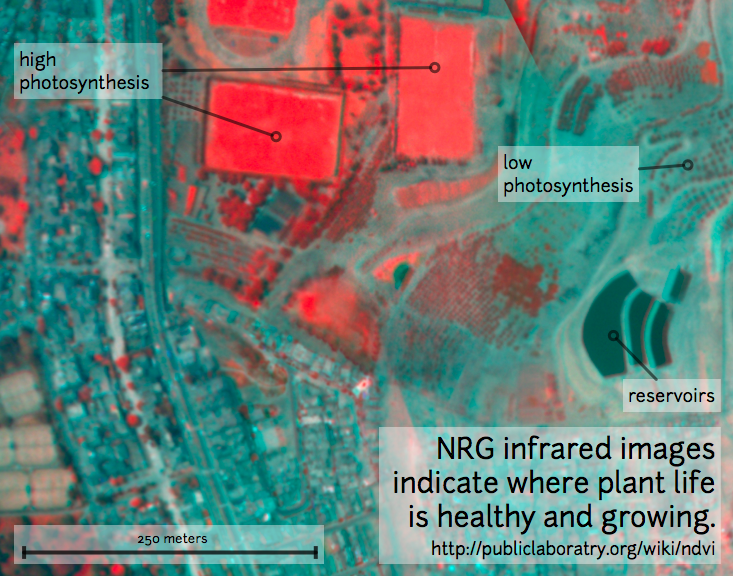](/i/25064) This diagram explains the swapping, which allows us to 'see' infrared as if it were a normal color: [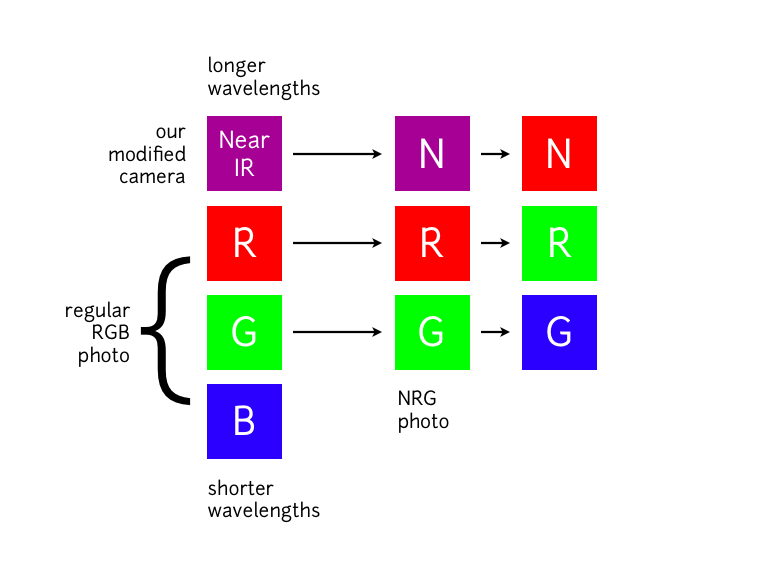](/i/25063) **In NRG images, the deeper and clearer the red color, the denser and healthier the vegetation (more or less).** ### Questions [questions:ndvi] ### Other examples of DIY NDVI imaging From around the internet: Begin watching at 2 minutes to see the resulting imagery: *This topic is part of the [Grassroots Mapping Curriculum](/wiki/mapping-curriculum) series.* **** [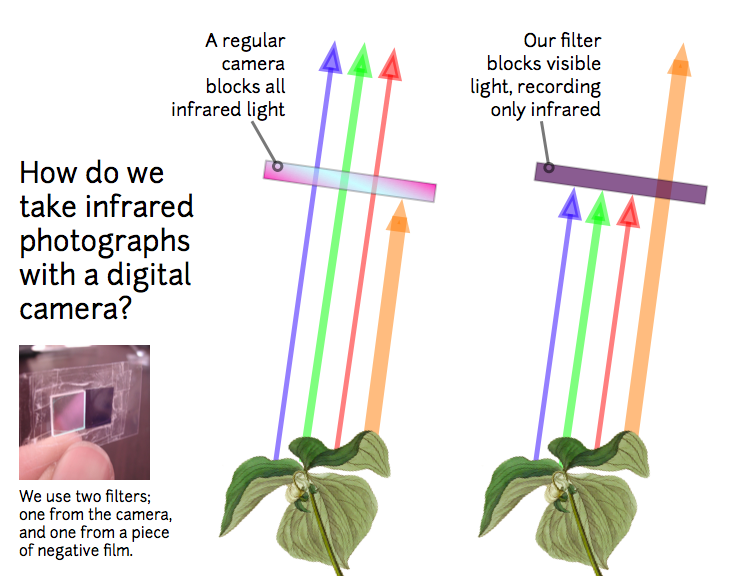](/i/25066) [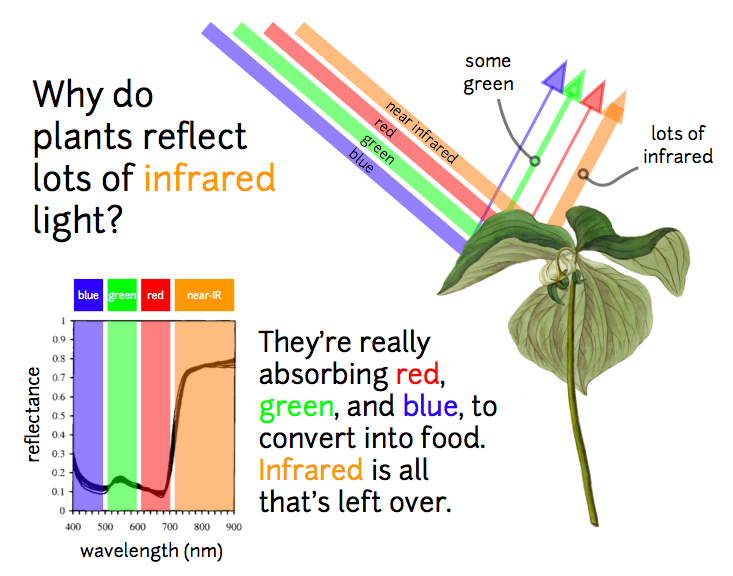](/i/25065) ...
| Author | Comment | Last activity | Moderation | ||
|---|---|---|---|---|---|
| jimsford | "where can i get that from? " | Read more » | over 9 years ago | |||
| warren | "Hi, you can do this online, actually, at http://infragram.org, if you use a single image. But for some samples, go back in the history for research..." | Read more » | over 9 years ago | |||
| Marlin | "For Warren, Where can I get two starter images like you used here so that I can learn to do the NDVI transformation in GIMP: http://publiclab.org..." | Read more » | over 9 years ago | |||
| cfastie | "Oh, that's what's happening. I wondered how it worked at all in Chrome without Silverlight support. In all other browsers you see overlays of zooma..." | Read more » | over 9 years ago | |||
| peauproductions | "Hello Ned, can you please contact me: nolan@peauproductions.com. We have a new dual-band NDVI filter and would like to ask you some questions, tha..." | Read more » | over 9 years ago | |||
| warren | "Cool, the Photosynth viewer for Chrome is done in HTML5, natively - no plugin! Pretty neat. " | Read more » | over 9 years ago | |||
| fjcaceres | "Hi Pat Thanks for your suggestion on the Forum address I bought a Canon A1200 just like you, and two filters from Cris, one of them the Wratten25..." | Read more » | over 9 years ago | |||
| patcoyle | "I'm still around, but don't have special insight to the points you raise. Consider posting your observations and questions to the PL plots-infrared..." | Read more » | over 9 years ago | |||
| fjcaceres | "Chris On last thing on the Agribotix site is that they conclude the best filters are the blue ones Javier " | Read more » | over 9 years ago | |||
| fjcaceres | "Hi there The last post is over a year old so I don't know if there is anyone around to comment I am new to the IR NDVI scene and along many of the..." | Read more » | over 9 years ago | |||
| cfastie | "@fgiorlando, I assume the Hoya 25A filters are just as good as Wratten 25A filters for infrared photography. The Hoya glass filters would produce c..." | Read more » | over 9 years ago | |||
| cfastie | "There seems to be a lot of marketing hooey at the Agribotix site. They seem to be doing DIY uncalibrated infrared vegetation index work like a lot ..." | Read more » | over 9 years ago | |||
| fjcaceres | "Because I don't really know much about filters, I came across this company named Agribotix that do NDVI and below the next paragraph is their expla..." | Read more » | over 9 years ago | |||
| cfastie | "The angle from which the photo is taken and the angle of the sun do influence the NDVI result. NDVI values are a function of how much red and NIR l..." | Read more » | over 9 years ago | |||
| cfastie | "Stretching the histograms of either the NIR or VIS (or both) channels used to make NDVI is a trick that can produce more meaningful NDVI. I don't k..." | Read more » | over 9 years ago | |||
| kykytos | "Is it important the station in which the photo is taken? I mean, how do you differ infrared reflected radiation from infrared emitted radiation (th..." | Read more » | over 9 years ago | |||
| kykytos | "@cfastie What do you mean with 'stretching the histogram of the infrablue photo'? Because if it means to reduce blue levels (increase NDVI levels),..." | Read more » | over 9 years ago | |||
| cfastie | "A standard coefficient is a tough nut. The amount you would want to shift the NDVI values will differ a lot among photos. Exposure and color balanc..." | Read more » | over 9 years ago | |||
| warren | "It looks to me like both offer pretty good differentiation, but that the red filtered version depresses NDVI values. But since we're not assuming a..." | Read more » | over 9 years ago | |||
| warren | "You're right - we need to display the colormap in the saved images too -- but we haven't had any time to do further development on Infragram.org, s..." | Read more » | over 9 years ago | |||
| warren | "The colormap is based on one of yours: " | Read more » | over 9 years ago | |||
| cfastie | "Yes, I can't say much without seeing the originals. Someone familiar with what infragram.org does might be able to infer something. When I follow ..." | Read more » | over 9 years ago | |||
| warren | "Do you think there's nothing you can infer without the originals? I'm guessing you want to look at the blue/red gap? These are the camera serial n..." | Read more » | over 9 years ago | |||
| warren | "I think they're gone, honestly. The bug seems to affect images captured via the webcam direct connection, but not images which were uploaded. I don..." | Read more » | over 9 years ago |